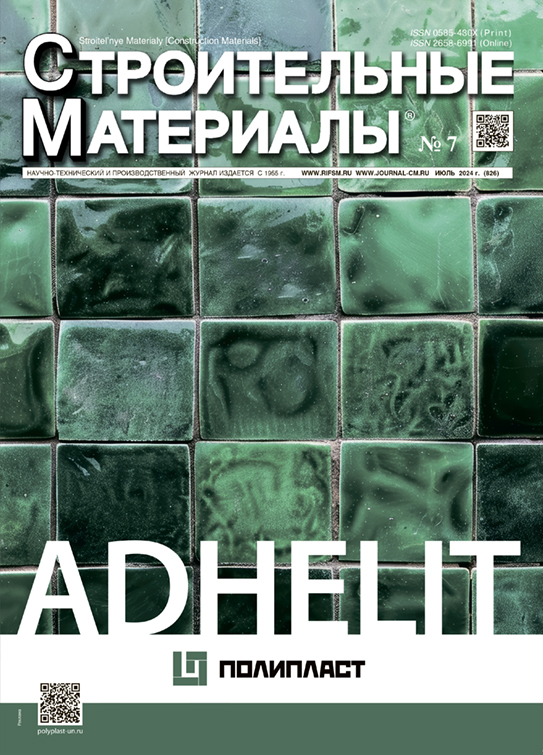The Influence of Potassium Sulfate, as Activator, on the Hardening Process of Insoluble Calcium Sulfate
- Autores: Buryanov A.F.1, Lukyanova N.A.1, Buldizhova E.N.2, Rebrov S.S.3
-
Afiliações:
- National Research Moscow State University of Civil Engineering
- Moscow Institute of Psychoanalysis
- GIPSTECH LLC
- Edição: Nº 7 (2024)
- Páginas: 7-10
- Seção: To Holding the XXIV International Conference of Manufacturers of Dry Building Mixes BALTIMIX-2024 (Perm, 20-23 August)
- URL: https://journals.eco-vector.com/0585-430X/article/view/635028
- DOI: https://doi.org/10.31659/0585-430X-2024-826-7-7-10
- ID: 635028
Citar
Texto integral
Resumo
A fairly large number of works by both Russian and foreign researchers have been devoted to the development of building materials based on anhydrite binders. An astringent based on insoluble anhydrite refers to slow-hardening. This fact often deters manufacturers of building materials from using this binder. To date, there are many activators for the hardening of insoluble anhydrite. The efficiency of accelerators depends on a number of factors. But there is no unambiguous explanation for the action of additives used to obtain anhydrite materials with optimal properties, and this problem needs a comprehensive study. The use of anhydrite in the production of building products and materials is a promising direction in construction, since anhydrite binder is an interchangeable local material and can be used instead of cement or gypsum binders.
Palavras-chave
Texto integral
Sobre autores
A. Buryanov
National Research Moscow State University of Civil Engineering
Autor responsável pela correspondência
Email: rga-service@mail.ru
Doctor of Sciences (Engineering)
Rússia, MoscowN. Lukyanova
National Research Moscow State University of Civil Engineering
Email: galcevanadezda@mail.ru
Candidate of Sciences (Engineering)
Rússia, MoscowE. Buldizhova
Moscow Institute of Psychoanalysis
Email: nusik-9o@yandex.ru
Candidate of Sciences (Engineering)
Rússia, MoscowS. Rebrov
GIPSTECH LLC
Email: srebrov@list.ru
Engineer
Rússia, Latnaya working village, Voronezh regionBibliografia
- Buryanov A.F., Lukyanova N.A., Buldyzhova E.N., Rebrov S.S. Increasing the efficiency of production and use of gypsum materials and products. Collection of materials from the XI International Scientific and Practical Conference «Increasing the efficiency of production and use of gypsum materials and products». Karachay-Cherkess Republic, Arkhyz village, September 20–21, 2023, pp. 44–50. (In Russian).
- Vtorov B., Fischer H.B. Influence of hardening activators on the properties of anhydrite binders. Materials of the Second International Scientific and Technical Seminar: Non-traditional technologies in construction. 2001, pp. 371–376. (In Russian).
- Klimenko V.G. The role of double salts based on Na+, K+, Ca2+, NH4+ sulfates in the technology of producing anhydrite binders. Vestnik BSTU named after V.G. Shukhova. 2017. No. 12, pp. 119–125. (In Russian).
- Golosovker I.Ya. Issledovaniye svoystv angidritovogo tsementa na baze Severnykh gipsov [Study of the properties of anhydrite cement based on Northern gypsum]. Arkhangelsk: Arkhangelsk Forestry Engineering Institute named after. V.V. Kuibysheva, 1948. 39 p.
- Conley R.F., Bundy W.M. Mechanism of gypsification. Geochimica et Cosmochimica Acta. 1958. Vol. 15. Iss. 1–2, pp. 57–72. https://doi.org/10.1016/0016-7037(58)90010-3
- Daumantas E.P. Study of solubility, hydration and hardening of anhydrite. Dis... Candidate of Sciences (Engineering). Kaunas. 1965. (In Russian).
- Tkacheva O.A. Hydration and hardening of anhydrite binder based on phosphogypsum. Candidate of Sciences (Engineering). Moscow, 1997. 203 p. (In Russian).
- Kudyakow A., Anikanowa L. Fluorahydritbindemitel fur die herstellung von baumaterialien. In 14. Internationale Baustofftagung «Ibausil». Tagungsbericht_Band 1. Weimar, 2000, pp. 269–275
- Klimenko V.G., Pavlenko V.I., Gasanov S.K. The Role of pH medium in forming binding substauces on base of calcium sulphate. Middle-East Journal of Scientific Research. 2013. Vol. 17. No. 8, pp. 1169–1175.
- Novichenkova T.B. Modeling of dispersed systems from gypsum technogenic resources for the production of composites for construction purposes. Dis... Candidate of Sciences (Engineering). Kazan. 2012. 212 p. (In Russian).
- Fischer H.B., Vtorov B. Influence of hardening activators on the properties of natural anhydrite. II International Meeting on Cement Chemistry and Technology. Vol. 2. Moscow. December 4–8, 2000, pp. 53–61. (In Russian).
Arquivos suplementares











